The park today contains many more trees than it did when it was formed, despite the death of numerous old trees during the past 40 years. A large number of young trees have come up by themselves in the vicinity of mature trees, but there are also many trees and shrubs that have been planted, either to revegetate cleared areas or to increase the diversity of existing woodland.
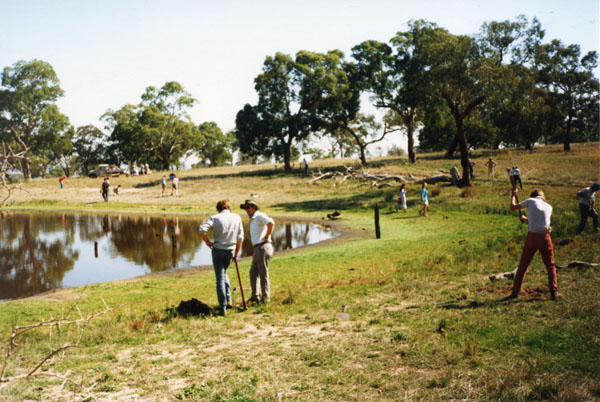
Little revegetation took place before the formation of the Friends of Gellibrand Hill Park (now Friends of Woodlands Historic Park) in June 1982. This is not to say that all plantings have been done by the Friends group, as many groups such as schools, army cadets, cubs and scouts have been involved over the years. The first plantings took place in the picnic area at Somerton Road, followed by a large amount of revegetation in the Back Paddock. The main tree species planted have been Red Gum, Grey and Yellow Box, Drooping Sheoke, Black and Golden Wattle and Sweet Bursaria. Manna Gum was also planted along Greenvale Creek. Shrubs planted include Tree Violet, Wedge-leafed Hop Bush, Gold Dust Wattle and Western Golden-Tip.
Plants were originally protected from rabbits with short wire netting guards assembled by the volunteers, and these can unfortunately still be found at the base of trees around the park.
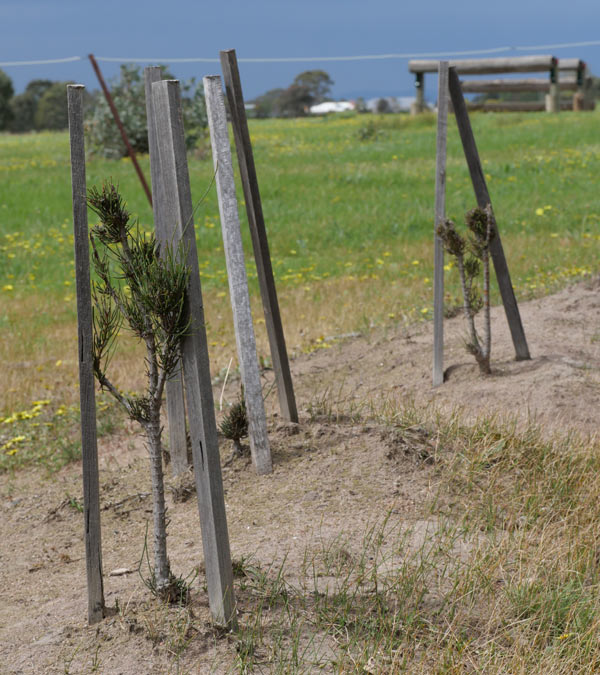
Most trees and shrub species while young are susceptible to browsing by Kangaroos. Originally Kangaroo browsing was not an issue because there were very few of them in the park. The Bandicoot page records the increase in Kangaroo numbers in the back paddock. By the time numbers became significant many of the planted trees were too high to suffer significantly from browsing. However Sheokes are slow growing and these were eaten off at a comfortable Kangaroo munching height for years, eventually growing to maturity when Kangaroo numbers decreased.
Some of the main areas planted in what was then the Back Paddock were erosion control areas near the quarries and south of Gellibrand Hill. Gellibrand Hill itself was also a focus. For example, 1000 trees and shrubs were planted there in the Spring of 1985, and more planting took place after the construction of the new radar facility in the early 1990s. Planting of Sheoke and Sweet Bursaria took place over a fairly wide area of the back paddock.
An example of an early (1991) tree planting project outside of the back paddock is the area just south of the creek and west of the park depot entrance drive. This is part of an area known as the "conservation zone". It is the lower right part of area 12 on the clickable map and was previously an open paddock.
For a long time most of the plants used in the park were grown in the park's own nursery, situated at the homestead until facilities were constructed at the new Park Depot. The nursery was run by park staff with assistance from Friends of Gellibrand Hill Park until 1986, after which it was operated and maintained solely by the Friends Group. Plants are propagated in the nursery from seed collected in the park, with the exception of species that had been lost from the area such as Wedge-leafed Hop Bush.
Some plantings, such as those by Melbourne Water along the creek and more recently by Conservation Volunteers Australia in the back paddock, are sourced from commercial nurseries and as far as we know the source of the seed has not been recorded.
The Restoration Plan (Carr et al. 1996) proposed restoring the original "scrub" on the hill above Woodlands Homestead and across to the sugar gum plantation, and this work commenced in 1999.
photo by Joan Thrush
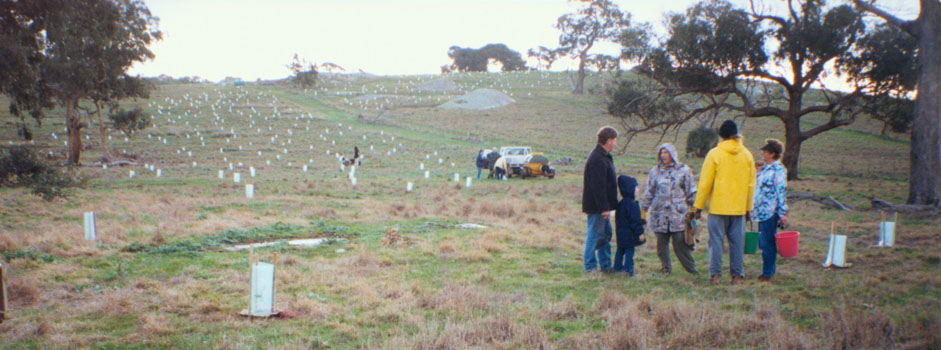
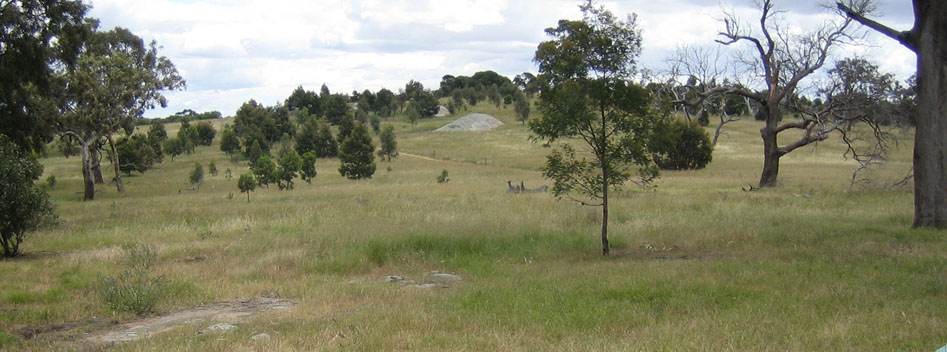
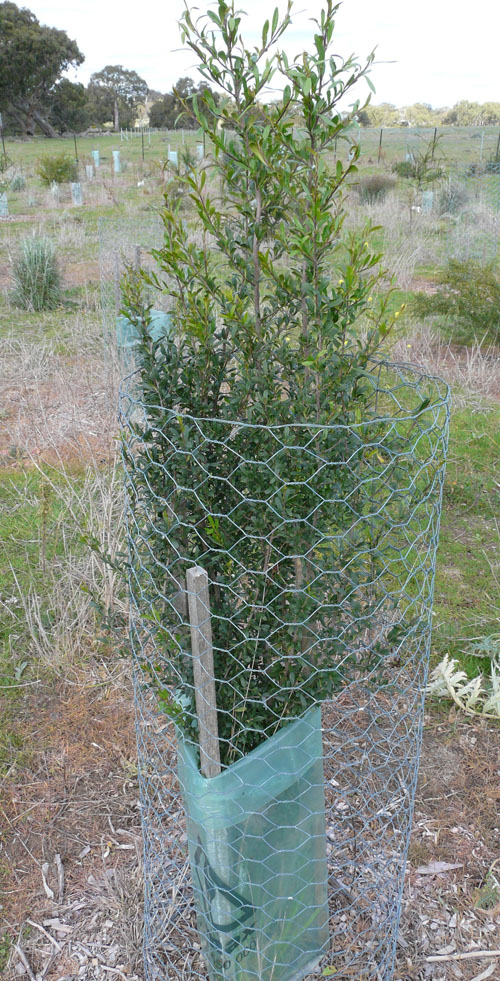
By this time Kangaroos had increased to high numbers outside of the Back Paddock, to the point where planted trees protected only by plastic guards either did not survive or had very retarded growth, depending on species. Taller plastic film guards were trialled but were quickly ripped to shreds, and Melbourne Water has had little success with rigid plastic guards. On several occasions contractors have attempted revegetation using "Sentry" Kangaroo repellent, but in the most recent attempt in 2014 almost nothing except the prickly wattles survived. On this project, adjacent to the bike path Southwest of the back paddock, rabbit guards were not used either. It was part of the "Two Million Trees" project, which in the case of Woodlands Historic Park somehow became the Eight Thousand Shrubs project. Surely one of the least impressive vote buying exercises ever.
Friends of Woodlands Historic Park have settled on the use of Kangaroo resistant wire netting guards 1.2m high and 0.5m diameter, held down by tent pegs. These are relatively expensive (and labour intensive to make) but can generally be reused several times. The diameter is a compromise - if they are made smaller there is more tendency for the tree to grow through the mesh, and if they are larger they are more flimsy and more expensive.
Note that the Kangaroos do not appear to prevent natural regeneration, at least of Eucalypts and wattles in wet years.
Since 2005 FOWHP have concentrated their efforts on the the newer parts of the park, Twin Dams Paddock and the former Greenvale Sanatorium/Northwest Hospital land, as well as Providence Road which separates them. Some recent FOWHP projects are illustrated on the Friends of Woodlands Historic Park site.
Grasses and Herbaceous Plants
In general, one should use the term "tree planting" rather than revegetation to describe most of the work done in the park, as the latter implies restoring the original vegetation, including grasses and other ground layer plants. As far as we know the first successful attempt to re-establish native grass in the park was in the erosion zone south of Gellibrand Hill where direct seeding of Kangaroo Grass took place in March 1993.
Since 2005 FOWHP have made some experimental attempts to replace small patches of Chilean Needle Grass with Kangaroo Grass. Two methods have been tried, planting individual plants grown in the nursery and direct seeding. The patches have been protected with temporary 1.2 m high netting fences. (While adult Kangaroos can easily jump these fences, they don't seem to do so if the fenced area is small enough, for example 12m square.) The disadvantage of planting nursery grown grasses, other than the enormous amount of labour needed, is that a considerable amount of weed control is needed for several years after planting. With direct seeding a much higher density can be achieved, preventing weed germination. Direct seeding requires very large amounts of seed. This is not really a problem because Parks Victoria have a mechanical grass seed harvester, and there is still a fairly large area of Kangaroo Grass in the Back Paddock which can be harvested.
In any case, FOWHP have discontinued these experiments because it was found that after the temporary fencing is removed, chronic overgrazing by Kangaroos results in a return of the weeds. The main grass planted by FOWHP in more recent years has been Common Tussock Grass, which is useful for erosion control in well-watered drainage lines. It is unpalatable to Kangaroos once it is a few years old, although they do eat it under drought conditions.
More recently Conservation Volunteers Australia have been planting very large numbers of nursery grown grasses and herbs in the back paddock, where there are currently no Kangaroos, although these plantings must still be protected from rabbits. So far they they have done no direct seeding.